
Olmsted was on to something
- November 12, 2008
- 4:21 pm
- November 12, 2008
- 4:21 pm

Frederick Law Olmsted, who designed Rochester’s Seneca/Maplewood, Genesee Valley, and Highland Parks, was convinced that exposure to nature was necessary to counteract the effects of city life. Here’s what Olmsted and his design partner Calvert Vaux had to say, describing their plan for Central Park:
[The purpose of urban parks is to provide] the feeling of relief experienced by those entering them, on escaping from the cramped, confined and controlling circumstances of the streets of the town; in other words, a sense of enlarged freedom is to all, at all times, the most certain and the most valuable gratification afforded by a park. [cited in Witold Rybczynski, A Clearing in the Distance]
Here’s how I described this in the National Register Documentation for the Municipal Park System of Rochester:
Olmsted’s urban parks were intended, first and foremost, to contrast with the city. Like other advocates of the pleasure ground movement, Olmsted firmly believed that access to nature could be physically and psychically restorative to city dwellers. He stated that landscapes with the right combination of characteristics could “refresh and delight the eye and through the eye, the mind and spirit.” Olmsted was convinced that this restorative process could only work subconsciously, through exposure to an environment that appeared to be totally natural, even if it was actually manipulated to some degree.
Olmsted’s approach was to create large urban parks (pleasure grounds), their specific character rooted in nature but enhanced by the skilled hand of a landscape architect, that provided access to the particular scenic effects that had the most positive psychological impacts on park visitors. In Rochester, Olmsted designed a classic pastoral landscape (gently rolling hills, calm water, and broad curves, intended to provide a sense of unity and harmony) for Genesee Valley Park, and a contrasting picturesque landscape (rugged terrain, bold landforms, and dramatic scenery, intended to inspire awe at the mystery and grandeur of nature) for Seneca/Maplewood Park. Scientific research appears to support Olmsted’s views on the restorative power of nature. A recent blog post uses 21st-century language to describe a very 19th-century, Olmstedian concept:
Thoreau would have liked this study: interacting with nature (at least when compared to a hectic urban landscape) dramatically improves improve cognitive function. In particular, being in natural settings restores our ability to exercise directed attention and working memory, which are crucial mental talents. The basic idea is that nature, unlike a city, is filled with inherently interesting stimuli (like a sunset, or an unusual bird) that trigger our involuntary attention, but in a modest fashion. Because you can’t help but stop and notice the reddish orange twilight sky – paying attention to the sunset doesn’t take any extra work or cognitive control – our attentional circuits are able to refresh themselves. A walk in the woods is like a vacation for the prefrontal cortex.
The next time you feel like you need to restore your psyche, spend some time in an Olmsted park, and thank Frederick Law Olmsted, a man ahead of his time, for his magnificent gifts to our city.
Posted by Katie Eggers Comeau, Advocacy Coordinator
SHARE




